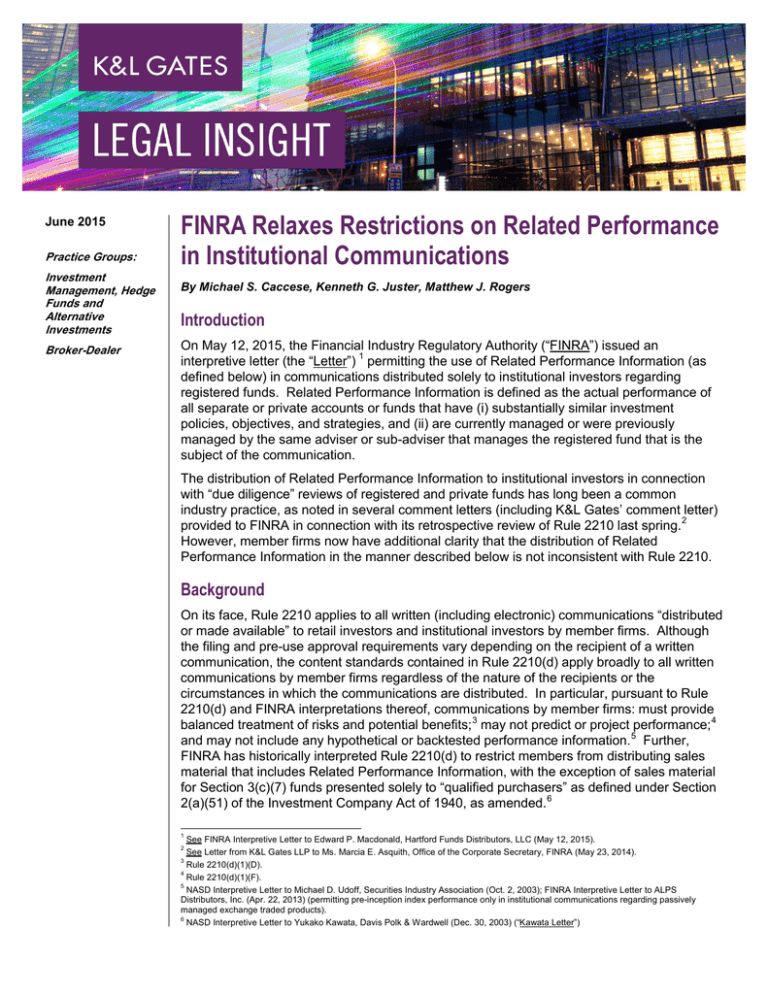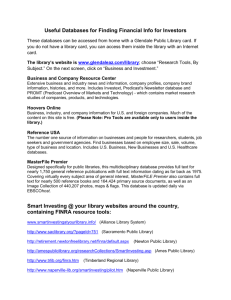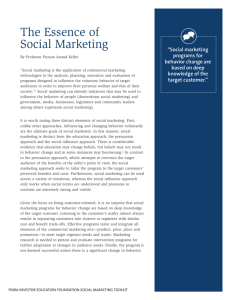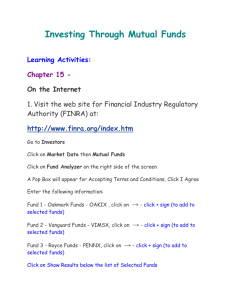FINRA Relaxes Restrictions on Related Performance in Institutional Communications Introduction
advertisement

June 2015 Practice Groups: Investment Management, Hedge Funds and Alternative Investments Broker-Dealer FINRA Relaxes Restrictions on Related Performance in Institutional Communications By Michael S. Caccese, Kenneth G. Juster, Matthew J. Rogers Introduction On May 12, 2015, the Financial Industry Regulatory Authority (“FINRA”) issued an interpretive letter (the “Letter”) 1 permitting the use of Related Performance Information (as defined below) in communications distributed solely to institutional investors regarding registered funds. Related Performance Information is defined as the actual performance of all separate or private accounts or funds that have (i) substantially similar investment policies, objectives, and strategies, and (ii) are currently managed or were previously managed by the same adviser or sub-adviser that manages the registered fund that is the subject of the communication. The distribution of Related Performance Information to institutional investors in connection with “due diligence” reviews of registered and private funds has long been a common industry practice, as noted in several comment letters (including K&L Gates’ comment letter) provided to FINRA in connection with its retrospective review of Rule 2210 last spring.2 However, member firms now have additional clarity that the distribution of Related Performance Information in the manner described below is not inconsistent with Rule 2210. Background On its face, Rule 2210 applies to all written (including electronic) communications “distributed or made available” to retail investors and institutional investors by member firms. Although the filing and pre-use approval requirements vary depending on the recipient of a written communication, the content standards contained in Rule 2210(d) apply broadly to all written communications by member firms regardless of the nature of the recipients or the circumstances in which the communications are distributed. In particular, pursuant to Rule 2210(d) and FINRA interpretations thereof, communications by member firms: must provide balanced treatment of risks and potential benefits; 3 may not predict or project performance; 4 and may not include any hypothetical or backtested performance information. 5 Further, FINRA has historically interpreted Rule 2210(d) to restrict members from distributing sales material that includes Related Performance Information, with the exception of sales material for Section 3(c)(7) funds presented solely to “qualified purchasers” as defined under Section 2(a)(51) of the Investment Company Act of 1940, as amended. 6 1 See FINRA Interpretive Letter to Edward P. Macdonald, Hartford Funds Distributors, LLC (May 12, 2015). See Letter from K&L Gates LLP to Ms. Marcia E. Asquith, Office of the Corporate Secretary, FINRA (May 23, 2014). 3 Rule 2210(d)(1)(D). 4 Rule 2210(d)(1)(F). 5 NASD Interpretive Letter to Michael D. Udoff, Securities Industry Association (Oct. 2, 2003); FINRA Interpretive Letter to ALPS Distributors, Inc. (Apr. 22, 2013) (permitting pre-inception index performance only in institutional communications regarding passively managed exchange traded products). 6 NASD Interpretive Letter to Yukako Kawata, Davis Polk & Wardwell (Dec. 30, 2003) (“Kawata Letter”) 2 FINRA Relaxes Restrictions on Related Performance in Institutional Communications As noted in the Letter, institutional investors often request Related Performance Information from member firms in connection with their review and “due diligence” analysis of a mutual fund. Such information often forms a critical part of the institutional investor’s due diligence of the fund and its investment adviser, particularly where the fund has limited operating history, and assists the institutional investor in determining whether the fund is a suitable investment for its customers. Accordingly, to avoid impeding an institutional investor’s analysis of a fund, an industry practice has developed over time whereby member firms provide Related Performance Information upon an institutional investor’s request, notwithstanding the restrictions of Rule 2210(d). Interpretive Relief In recognition of the overbroad application of Rule 2210(d) and the fact that communications provided solely to institutional investors do not raise the same investor protection concerns as materials provided to retail investors, FINRA has relaxed its historic position and will now allow the use of Related Performance Information in institutional communications. In addition to complying with all other applicable FINRA rules and federal securities laws, communications containing Related Performance Information are subject to the following conditions: • The materials must be provided only to “institutional investors” as defined in FINRA Rule 2219(a)(4);7 • The Related Performance Information must: (i) include all accounts that are within the definition of Related Performance Information (“Related Accounts”); (ii) be for a period of at least one year and since the inception of the investment strategy; (iii) be current as of the most recently ended calendar quarter; and (iv) be clearly labeled as such and contain clear disclosure of the applicable dates for the performance; • If there are multiple Related Accounts, they must be presented: (i) in a composite; or (ii) with equal prominence in a list; • Any communication with Related Performance Information must be clearly labeled “for use with institutions only, not for use with retail investors,” and recipients must be instructed not to provide the communication to noninstitutional investors; • The Related Performance Information must be shown net of fees and expenses of the Related Accounts, or net of a model fee that is the highest fee charged to any account managed in the strategy. Gross performance may also be shown, along with required disclosures; • The fees and expenses of the registered fund that is the subject of the communication must be disclosed, and the registered fund’s actual performance must be shown net of fees and more prominently than the Related Performance Information; and 7 “Institutional investor” includes a: bank, savings and loan association, insurance company or registered investment company; investment adviser registered either with the SEC under Section 203 of the Investment Advisers Act or with a state securities commission (or any agency or office performing like functions); any other person (whether a natural person, corporation, partnership, trust, or otherwise) with total assets of at least $50 million; a governmental entity or subdivision thereof; an employee benefit plan, or multiple employee benefit plans offered to employees of the same employer, that meet the requirements of Section 403(b) or Section 457 of the Internal Revenue Code and in the aggregate have at least 100 participants, but does not include any participant of such plans; a qualified plan, as defined in Section 3(a)(12)(C) of the Exchange Act, or multiple qualified plans offered to employees of the same employer, that in the aggregate have at least 100 participants, but does not include any participant of such plans; a FINRA member or registered person of such a member; and a person acting solely on behalf of any such institutional investor. 2 FINRA Relaxes Restrictions on Related Performance in Institutional Communications • The communication must disclose any material differences between the funds or accounts for which Related Performance Information is provided and the registered fund that is the subject of the communication. FINRA’s position that the presentation of Related Performance Information to retail investors does not comply with Rule 2210 remains unchanged by this interpretive relief. Analysis and Interpretive Issues The relief granted by FINRA in the Letter provides much needed clarity to member firms regarding their compliance with Rule 2210 when faced with requests by institutional investors for Related Performance Information. However, the relief also leaves a number of interpretive questions unanswered. For example: • The Letter primarily addresses the provision of Related Performance Information in response to requests from institutional investors that are intermediaries in connection with their due diligence reviews of registered funds. It is unclear whether member firms may provide Related Performance Information in registered fund marketing materials that have not been specifically requested by an institutional investor. However, because FINRA adopts the rationale used in the Kawata Letter (concerning “sales materials” for Section 3(c)(7) funds) in granting this interpretive relief, we can infer that the use of Related Performance Information in registered fund “sales materials” provided solely to institutional investors is also permitted. 8 • Pursuant to the Letter and the Kawata Letter, Related Performance Information may now be presented in communications relating to: (1) Section 3(c)(7) funds, provided the recipients are “qualified purchasers”; and (2) registered funds, provided the recipients are “institutional investors.” However, FINRA has not addressed the use of Related Performance Information in communications regarding other types of securities products, such as Section 3(c)(1) funds, Section 3(c)(11) funds, or Rule 144A offerings, which require investors to meet standards other than “qualified purchaser” or “institutional investor.” Further, if a registered fund has both retail and institutional investors, providing Related Performance Information only to “institutional investors” creates a potential selective disclosure issue similar to that illustrated by FINRA in its interpretive letter to Budge Collins, Collins/Bay Island Securities. 9 This concern can be ameliorated by ensuring that any Related Performance Information that is provided to institutional investors is also included in the registered fund’s offering documents. • The Letter represents a step toward harmonizing FINRA and U.S. Securities and Exchange Commission (“SEC”) advertising standards. For example, registered investment advisers and funds are explicitly permitted to provide Related Performance Information to prospective investors under SEC rules and staff 8 Firms claiming compliance with the Global Investment Performance Standards (“GIPS”) are not currently required to treat prospective registered fund investors as “prospective clients” to whom the firm must provide a presentation that complies with the GIPS standards. Under the current standards, the “prospective client” is the registered fund and its board of directors. At the GIPS 2013 Annual Conference, a member of the GIPS Executive Committee indicated that the committee was considering guidance that would require firms to provide fund investors with a compliant presentation. No guidance has yet been proposed. 9 FINRA Interpretive Letter to Budge Collins, Collins/Bay Island Securities (Sept. 14, 2004) (…by restricting the dissemination of [related performance] information to QIBs, there is the possibility that those potential investors who qualify as QIBs will be treated differently than other potential investors and will have access to information that is not available to others. With 3(c)(7) funds, the risk of disparate treatment of potential investors is ameliorated by the fact that, with few exceptions, all investors in a 3(c)(7) fund must be qualified purchasers.”). 3 FINRA Relaxes Restrictions on Related Performance in Institutional Communications guidance. 10 However, FINRA’s guidance applies only to institutional investors. Accordingly, registered representatives of member firms who are also associated persons of a fund’s investment adviser (“Dual Employees”) must continue to attempt to delineate when they are communicating on behalf of the investment adviser, particularly when communicating with noninstitutional investors. While the Letter will not result in a fundamental shift in the industry’s approach to providing Related Performance Information, it does provide welcome clarity for member firms that providing Related Performance Information to institutional investors does not violate Rule 2210. Perhaps more importantly, it also represents an important step in FINRA’s ongoing efforts to interpret its rules in a way that better aligns their investor protection benefits with their impact on member firms and other market participants. Authors: Michael S. Caccese Kenneth G. Juster Matthew J. Rogers michael.caccese@klgates.com +1. 617.261.3133 ken.juster@klgates.com +1. 617.261.3296 matthew.rogers@klgates.com +1. 617.951.9147 Anchorage Austin Beijing Berlin Boston Brisbane Brussels Charleston Charlotte Chicago Dallas Doha Dubai Fort Worth Frankfurt Harrisburg Hong Kong Houston London Los Angeles Melbourne Miami Milan Moscow Newark New York Orange County Palo Alto Paris Perth Pittsburgh Portland Raleigh Research Triangle Park San Francisco São Paulo Seattle Seoul Shanghai Singapore Spokane Sydney Taipei Tokyo Warsaw Washington, D.C. Wilmington K&L Gates comprises more than 2,000 lawyers globally who practice in fully integrated offices located on five continents. The firm represents leading multinational corporations, growth and middle-market companies, capital markets participants and entrepreneurs in every major industry group as well as public sector entities, educational institutions, philanthropic organizations and individuals. For more information about K&L Gates or its locations, practices and registrations, visit www.klgates.com. This publication is for informational purposes and does not contain or convey legal advice. The information herein should not be used or relied upon in regard to any particular facts or circumstances without first consulting a lawyer. © 2015 K&L Gates LLP. All Rights Reserved. 10 For example, the staff of the SEC’s Division of Investment Management takes the position that a registered fund may include in its registration statement information concerning the performance of separate accounts and other funds managed by the fund’s adviser that have substantially similar investment objectives, policies, and strategies as the fund, provided that such information is not presented in a misleading manner and does not obscure or impede the understanding of information that is required to be in the fund’s registration statement (including the fund’s own performance). See Division of Investment Management IM Guidance Update No. 2013-05 (Aug. 2013); Nicholas-Applegate, SEC No-Action Letter (pub. avail. Aug. 6, 996); ITT Hartford Mutual Funds, SEC No-Action Letter (pub. avail. Feb. 7, 1997). 4







